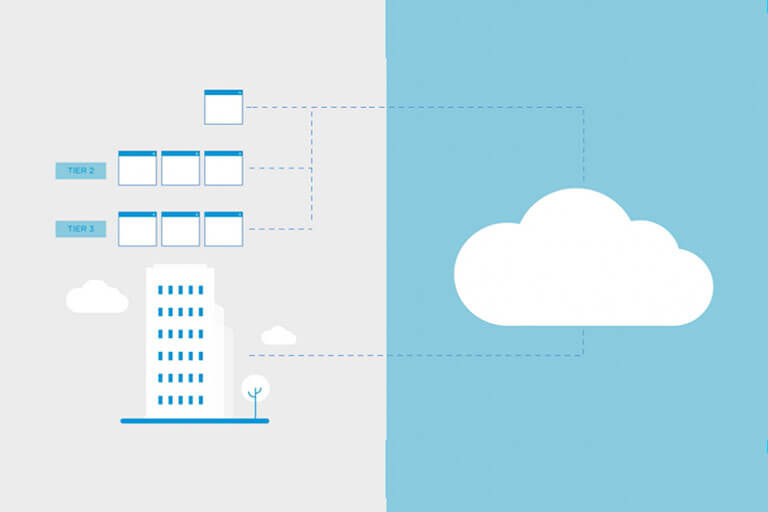 The use of the public cloud as a deployment platform for new applications and services has exploded in the last half-decade. However, most organisations are just not adopting a cloud-only approach to new deployments, they are using a hybrid cloud model that combines infrastructure from private data centres with services in the cloud. The proportion of organisations adopting this model has grown rapidly in the three years to 2020. Data from the IDC IaaSView Survey shows that 60% of organisations surveyed in 2020 were using some form of hybrid model (an increase from 36% in 2018, and 52% in 2019). I fully expect this trend to continue when the 2021 and future survey results are released, and that hybrid cloud will be the default standard for new IT projects.
The use of the public cloud as a deployment platform for new applications and services has exploded in the last half-decade. However, most organisations are just not adopting a cloud-only approach to new deployments, they are using a hybrid cloud model that combines infrastructure from private data centres with services in the cloud. The proportion of organisations adopting this model has grown rapidly in the three years to 2020. Data from the IDC IaaSView Survey shows that 60% of organisations surveyed in 2020 were using some form of hybrid model (an increase from 36% in 2018, and 52% in 2019). I fully expect this trend to continue when the 2021 and future survey results are released, and that hybrid cloud will be the default standard for new IT projects.
The Challenges of Moving to the Cloud
That said, moving production applications and services from traditional on-premise deployments to the cloud has its challenges. On many public cloud-based platforms, the underlying tools and management interfaces are different from what in-house IT professionals have been used to using on Windows Server, Linux, and other Unix based infrastructure. It is possible to deploy virtual machine (VM) server instances in the cloud and then manage them the same way as on-premise VMs, but this doesn’t bring the flexibility and cost reductions that most organisations want from the cloud.
Most IT teams can learn how to use the new tools and interfaces available in public cloud services, but this is a learning curve, and getting teams fully expert will usually involve extended training for many people. This can prove costly from a training budget perspective, and it can introduce delays in digital transformation projects that have financial implications if new services take longer to deploy for business use.
It would be better if IT teams could continue using and leveraging their knowledge from private infrastructure deployments when adopting a hybrid cloud model. It turns out that for a majority of IT teams, they can do just that by using VMware Cloud on AWS.
How VMware on AWS Makes Cloud Migration Easier
VMware’s vSphere and associated tools are the most common server hosting and management platform in use within organisations. Many IT professionals know how to use VMware to deliver the hosting platform organisations need to run Windows Servers, Microsoft stack applications, Linux servers, containers, and Kubernetes.
VMware Cloud on Amazon Web Services (AWS) acknowledges that this knowledge base exists. It enables the use of the flexible cloud compute and storage available via native AWS services using the same and familiar management tools available in VMware. The Software Designed Data Centre (SDDC) stack available for on-premise VMware deployments is available in VMware Cloud on AWS deployments. VMware Cloud on AWS is a VMware Cloud Foundation cloud environment, including vSphere, vSAN, and NSX, built on Amazon EC2 bare metal servers. The AWS instances can be used and managed as if they were in a local server room. There is no need to train IT administrators in a new toolset to leverage AWS cloud resources.
Similarly, there is no need to redesign, re-architect or re-factor applications to move them to the cloud. They will run as-is across both on-premise and cloud-based VMware instances. Migration tools such as vSphere vMotion and HA also work in a hybrid VMware Cloud on AWS deployment. This means that admins can move production environments from on-premise infrastructure to the AWS cloud and vice versa without downtime.
By essentially removing the distinction between on-premise and AWS cloud infrastructure for IT teams, VMware Cloud on AWS allows for faster cloud adoption, lowers costs, and boosts business value for organisations, as I describe in the next section.
Migration Benefits of VMware Cloud for AWS
VMware Cloud for AWS is a ready-to-use VMware environment that is maintained and managed at the hardware level by VMware in partnership with AWS on the AWS public cloud. The first benefit of using the service is that the underlying cloud platform responsibility does not rest with your IT team. Still, they can continue to use familiar tools to manage services running in the cloud. They can provision virtual machines and manage their infrastructure on VMware Cloud on AWS using the same VMware tools and workflows used with the rest of the VMware environment.
The IDC report previously referenced goes into detail on the business befits of adopting VMware Cloud on AWS. I recommend that you download the PDF and read it yourself. Rather than repeat the info available there, I’ll present some of the headlines that are contained and detailed in the study:
- Surveyed organisations saw a 46% reduction in cloud migration timescales using VMware Cloud on AWS. The average was a 4.5-month reduction in project times.
- Migration projects using the technology had costs that were 57% lower than equivalent migrations to other cloud solutions.
- During the migrations, there was a 59% reduction in IT staff time dedicated to the projects, giving them more time to work on other business deliverables.
- After migrating to VMware Cloud on AWS, organisations saw an 83% reduction in unplanned downtime for applications and servers running in the cloud.
- Application performance increased by 27% post cloud adoption.
- Equivalent VMware workloads in the cloud cost 44% less to operate over a 3-year period.
- Businesses saw a 48% reduction in the staff time required for operations on the cloud-based instances over a 3-year period.
- Organisations that migrated and adopted a hybrid cloud model built on VMware Cloud on AWS saw a 351% ROI over the following 3-year period. With the average breakeven point being just eight months.
Building on this hybrid platform will also deliver the foundation for a cost-effective, robust disaster recovery and business continuity planning using VMware Site Recovery with the cloud.
Clearly, the use of VMware Cloud for AWS gives a myriad of benefits. But perhaps the best benefit is that it allows organisations of all sizes to build a future-proofed hybrid cloud platform that will enable agility and resilience in IT provision for future years. All built on the combination of global AWS services and the leading Enterprise infrastructure platform from VMware. A win-win.
PFH VMware Cloud Consultancy
At PFH Group, we have the skilled staff and resources to help our customers adopt VMware Cloud for AWS. We are a VMware partner and the accredited partner in Ireland for VMware cloud services.














